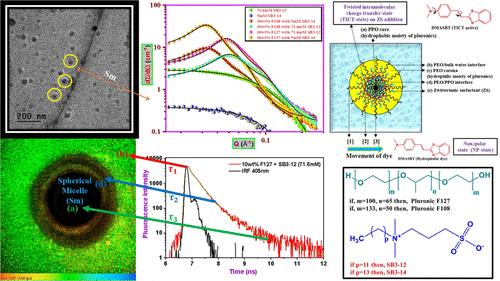解密聚羧酸共聚物表面活性剂的影响:光谱、显微镜和散射技术的协同奥德赛
IF 3.7
2区 化学
Q2 CHEMISTRY, MULTIDISCIPLINARY
引用次数: 0
摘要
有关pluronic-zwitterionic 表面活性剂混合组装体的光物理特性和微环境特征的基础研究,对于加深我们对纳米尺度分子相互作用的理解至关重要,从而为pluronic-zwitterionic 表面活性剂组装体在药物输送、诊断和其他应用领域的创新解决方案奠定基础。这项研究以形成苯乙烯染料反式-2-[(4-二甲基氨基)苯乙烯基]苯并噻唑的分子内电荷转移态扭曲为探针,探索了pluronic-齐聚物表面活性剂混合组装体错综复杂的光物理。通过比较嵌段组成为(PEO)132-(PPO)50-(PEO)132 [F108]和(PEO)100-(PPO)65-(PEO)100 [F127]的两种不同聚(环氧乙烷)-嵌段-聚(环氧丙烷)-嵌段-聚(环氧乙烷)嵌段共聚物在 5 和 10 wt % 浓度下的行为,本研究系统地考察了添加齐聚物表面活性剂的影响。通过一套全面的分析技术,包括紫外可见吸收、稳态发射和时间分辨荧光发射研究,观察到添加齐聚物表面活性剂后发射光谱和量子产率的显著变化。这些变化表明,染料分子在组装体内部各种微环境之间的转换达到了动态平衡。此外,动态光散射、ZETA 电位(ζ)、核奥弗霍塞尔效应光谱、小角中子散射、低温透射电子显微镜、场发射扫描电子显微镜和荧光寿命成像显微镜分析都揭示了表面活性剂的加入对组装体结构特性的重大影响。本文章由计算机程序翻译,如有差异,请以英文原文为准。

Deciphering the Influence of Zwitterionic Surfactants on Pluronic Co-assemblies: A Synergistic Odyssey through Spectroscopic, Microscopic, and Scattering Techniques
Fundamental investigations into the photophysical properties and microenvironmental features of pluronic–zwitterionic surfactant mixed assemblies are essential for advancing our understanding of molecular interactions at the nanoscale, setting the stage for innovative solutions in drug delivery, diagnostics, and other applications of pluronic–zwitterionic surfactant assemblies. This investigation explores the intricate photophysics of pluronic–zwitterionic surfactant mixed assemblies, utilizing the twisted intramolecular charge transfer state forming styryl dye trans-2-[(4-dimethylamino) styryl] benzothiazole as a probe. By comparing the behaviors of two distinct poly(ethylene oxide)-block-poly(propylene oxide)-block-poly(ethylene oxide) block copolymers with block composition of (PEO)132-(PPO)50-(PEO)132 [F108] and (PEO)100-(PPO)65-(PEO)100 [F127] at concentrations of 5 and 10 wt %, this study systematically examines the impact of the addition of zwitterionic surfactants. Through a comprehensive set of analytical techniques, including UV–visible absorption, steady-state emission, and time-resolved fluorescence emission studies, significant alterations in the emission spectra and quantum yields were observed upon the addition of zwitterionic surfactants. These modifications suggest a dynamic equilibrium for the transitioning of dye molecules between various microenvironments within the assemblies. Additionally, dynamic light scattering, zeta potential (ζ), nuclear Overhauser effect spectroscopy, small-angle neutron scattering, cryogenic transmission electron microscopy, field emission scanning electron microscopy, and fluorescence lifetime imaging microscopy analyses have shed light on the substantial impact of surfactant incorporation on the structural properties of assemblies.
求助全文
通过发布文献求助,成功后即可免费获取论文全文。
去求助
来源期刊

Langmuir
化学-材料科学:综合
CiteScore
6.50
自引率
10.30%
发文量
1464
审稿时长
2.1 months
期刊介绍:
Langmuir is an interdisciplinary journal publishing articles in the following subject categories:
Colloids: surfactants and self-assembly, dispersions, emulsions, foams
Interfaces: adsorption, reactions, films, forces
Biological Interfaces: biocolloids, biomolecular and biomimetic materials
Materials: nano- and mesostructured materials, polymers, gels, liquid crystals
Electrochemistry: interfacial charge transfer, charge transport, electrocatalysis, electrokinetic phenomena, bioelectrochemistry
Devices and Applications: sensors, fluidics, patterning, catalysis, photonic crystals
However, when high-impact, original work is submitted that does not fit within the above categories, decisions to accept or decline such papers will be based on one criteria: What Would Irving Do?
Langmuir ranks #2 in citations out of 136 journals in the category of Physical Chemistry with 113,157 total citations. The journal received an Impact Factor of 4.384*.
This journal is also indexed in the categories of Materials Science (ranked #1) and Multidisciplinary Chemistry (ranked #5).
 求助内容:
求助内容: 应助结果提醒方式:
应助结果提醒方式:


